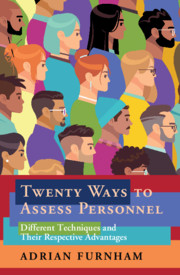Book contents
- Twenty Ways to Assess Personnel
- Twenty Ways to Assess Personnel
- Copyright page
- Dedication
- Contents
- Tables
- Preface
- Acknowledgements
- 1 Introduction to Selection and Assessment
- 2 Complex and Sticky Issues in Assessment and Selection
- 3 Traditional and Mainly Discredited Assessment Methods
- 4 Self-Report Tests
- 5 Observer Reports
- 6 Behavioural Tests
- 7 Physiology
- 8 Biography
- 9 Big Data
- 10 The Future of Assessment
- Index
- References
3 - Traditional and Mainly Discredited Assessment Methods
Published online by Cambridge University Press: 11 June 2021
- Twenty Ways to Assess Personnel
- Twenty Ways to Assess Personnel
- Copyright page
- Dedication
- Contents
- Tables
- Preface
- Acknowledgements
- 1 Introduction to Selection and Assessment
- 2 Complex and Sticky Issues in Assessment and Selection
- 3 Traditional and Mainly Discredited Assessment Methods
- 4 Self-Report Tests
- 5 Observer Reports
- 6 Behavioural Tests
- 7 Physiology
- 8 Biography
- 9 Big Data
- 10 The Future of Assessment
- Index
- References
Summary
Records of how to select people date back 3,000–5,000 years and there are supposed incidences in the Bible. There remain, to this day, an interest and belief in astrology despite there being little evidence that place and time of birth relate to any major individual difference factors. There is also still an interest in graphology, which is the belief that the dramatic differences in writing between individuals is an importantly and stable marker of personality or motivation. Study after study show there is no validity in handwriting analysis. The situation with regard to phrenology is different. The Victorians believed that the shape of the head reflected the shape of the brain which was primarily responsible for individual differences. The fanciful connect between head shape and brain location and psychological characteristics has however been revived by neuroscience and fMRI scanning. Similarly, the idea that body shape and build was a strong marker of personality has been discredited, but the modern interest in BMI and WHR has shown that these are indeed markers of different kinds of behaviour.
Keywords
- Type
- Chapter
- Information
- Twenty Ways to Assess PersonnelDifferent Techniques and their Respective Advantages, pp. 75 - 114Publisher: Cambridge University PressPrint publication year: 2021



